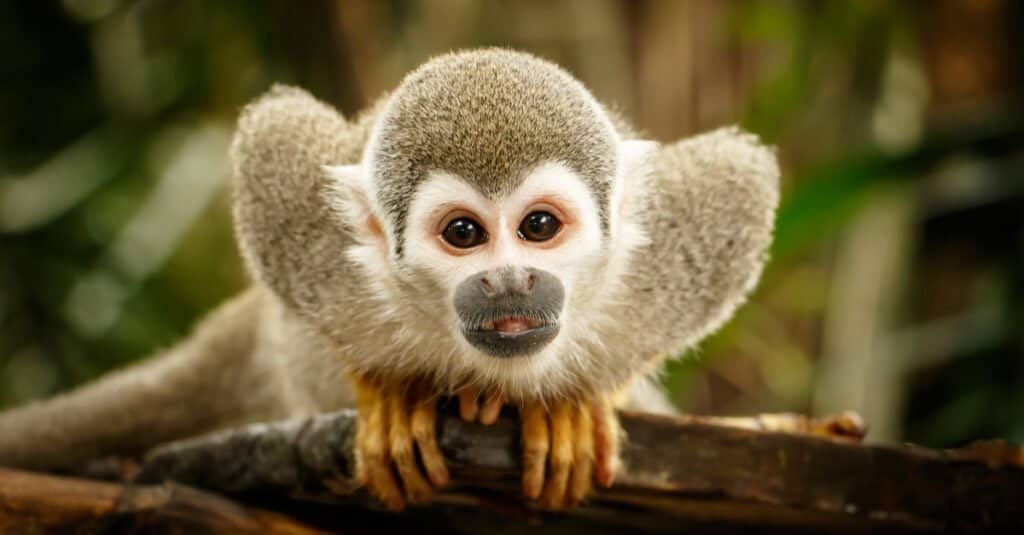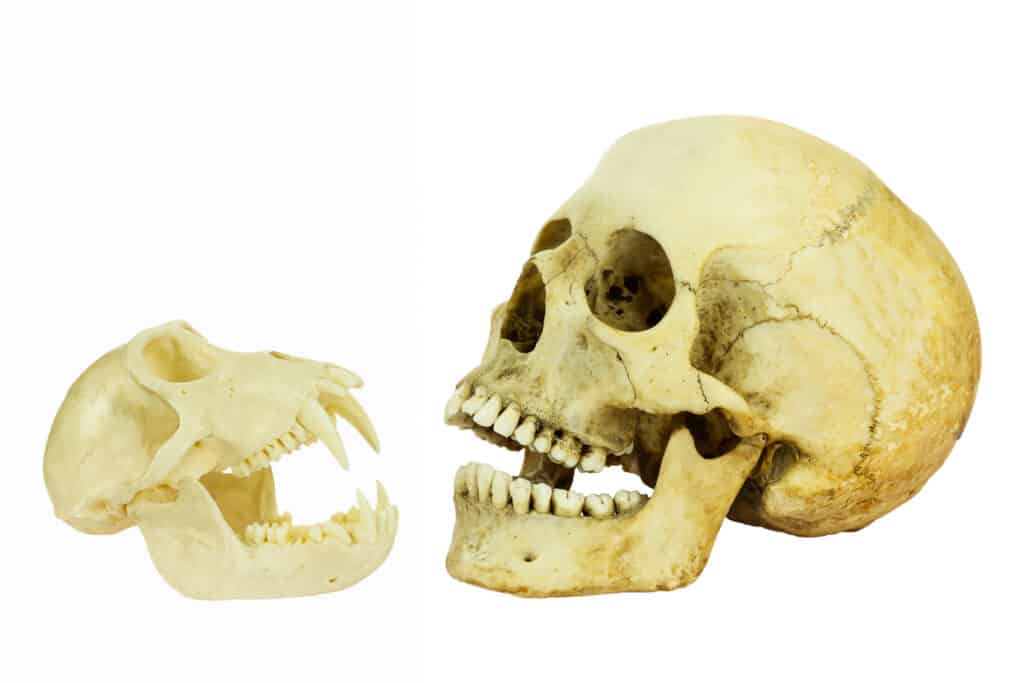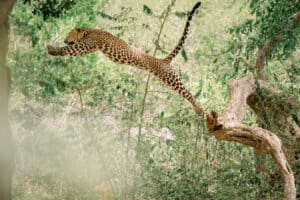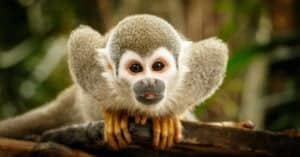Monkeys and apes have a common ancestor that lived about 20 to 25 million years ago. Humans and chimpanzees also have a common ape ancestor that lived somewhere between 8 and 6 million years ago. Monkeys’ history may not be as long and storied as some other creatures, but every time scientists unlock their past, they help us understand humans.
What’s a Monkey?

Monkeys and apes diverged about 20 to 25 million years ago.
©Ludmila Ruzickova/Shutterstock.com
Before we talk about the oldest monkey fossil ever found, we have to create some boundaries to the inquiry. We aren’t looking for the oldest primate fossils ever found but the oldest creatures considered a monkey. That being said, it’s important to know that apes and monkeys are two related but different types of animals.
Generally speaking, five differences exist between monkeys and apes, and they are:
- Monkeys have tails and apes generally do not.
- Apes are more intelligent than monkeys.
- Apes are larger and heavier than monkeys.
- Apes have a more mobile shoulder joint that allows them to engage in brachiation to a greater degree than monkeys.
- Apes are not present in the Americas while monkeys are present in Central and South America.
This article is only concerned with monkeys even though ancestors of both creatures can appear in the fossil record together.
Another division to consider is Old World monkeys vs New World monkeys. Old World monkeys are found in Asia and Europe these days, but New World monkeys live in Central and South America. This inquiry into the oldest monkey fossil ever found will not differentiate between non-ape monkeys from any location.
Having established a frame of reference for monkeys compared to other primates, it’s time to look at the oldest monkeys.
When Did Monkey Ancestors First Appear?

The common ancestor of all primates lived about 64.75 to 64.11 million years ago.
©Ben Schonewille/Shutterstock.com
Some scientists believe that creatures from the Purgatorius genus were the progenitors of all primates. However, it would be a mistake to call these creatures monkeys as we know them. Instead, they were small, rodent-like animals that resembled tree shrews.
These animals lived roughly 64.75 to 64.11 million years ago. Scientists found these remains in a very unlikely place, eastern Montana. Paleontologists found remains of Purgatorious unio and Purgatorious ceratops in 1965 at Purgatory Hill and Harbicht Hill.
Scientists recovered several remains from these areas, including teeth and dentary fragments. Some studies contend that these creatures are not as closely related to primates as scientists originally imagined. Others hold that the Purgatorious genus was the earliest relative of all primates. Either way, scientists need more information before reaching a higher level of understanding about these animals.
When Did the First True Monkeys Appear?
Monkeys, as we know them, did not appear 60 million years ago with Purgatorious. Instead, the earliest true monkey may have been Canaanimico amazonensis, a species that lived about 26.5 million years ago in Peru. The fossil remains of this species are somewhat lacking, consisting mostly of teeth.
Another one of the potential first true monkeys to appear was Branisella boliviana, a species of New World monkey that lived about 26 million years ago. As its name suggests, this creature once lived in Bolivia. Fossils of this creature were found in 1969. Like Canaanimico amazonensis, the remains of this creature consist of its teeth.
With this understanding of how long actual monkeys have been around, it’s time to look at some of the oldest monkey fossils ever discovered.
How Old Was the Oldest Monkey Fossil Ever Found?
The oldest monkey fossil ever was 26.5 million years old and belonged to Canaanimico amazonensis, the oldest New World Monkey discovered so far. Scientists discovered the fossils in Peruvian Amazonia and wrote a paper about the discovery in 2016. The discovery consisted of two upper molars. Even though that’s not much to go on, the discovery still gave researchers a great deal of insight.
Scientists have discovered fossils from Old World monkeys that are similar in age. For example, paleontologists dug out fossils of Nsungwepithecus gunnelli in Tanzania in 2013. These fossils are 25.2 million years old. They are similar in age to the New World monkey fossils, but not quite as old. Also, some people have speculated that these fossils belong to an early pig and not an early monkey given their similarities at that time.
Future discoveries could easily change what scientists know about the oldest monkey fossil ever found. Every new fossil helps close the knowledge gap about the evolution of primates.
What Did the Oldest Monkey Fossil Teach Us?

We’re still discovering new primates today. In fact, 36 new species were discovered in the 2010s!
©Robert Ross/Shutterstock.com
The discovery of the oldest monkey fossils helped teach scientists more about the evolution of primates. Not only does learning about the oldest monkeys help scientists fill in the gaps concerning how primates evolved, but it can also help them understand the evolution of humans as well. After all, humans and primates have some common ancestry.
Another important thing that the oldest monkey fossils have helped teach people is how monkeys spread around the world. Old World monkeys and New World monkeys live in areas separated by oceans in the present. That was not always the case, and scientists are eager to learn how the early species radiated outward from their points of origin.
Currently, scientists believe that primates evolved in Asia even though a lot of the oldest fossils are found in North America and parts of Europe. At some point, early apes migrated from Europe or Asia into Africa. These theories on the origins of primates are supported by fossil evidence. However, a great deal more evidence is required to truly understand the origin of primates.
Furthermore, scientists need more data to figure out when the earliest species began to diverge from one another. Although the oldest monkey fossils are helpful in that endeavor, they certainly do not provide the most complete picture of the issue.
Up Next:
- What’s the Oldest Alligator Fossil Ever Found?
- What’s the Oldest Crocodile Fossil Ever Found?
- What’s the Oldest Elephant Fossil Ever Found?
- What Is the Oldest Whale Fossil Ever Found?
The photo featured at the top of this post is © Ben Schonewille/Shutterstock.com
Thank you for reading! Have some feedback for us? Contact the AZ Animals editorial team.






